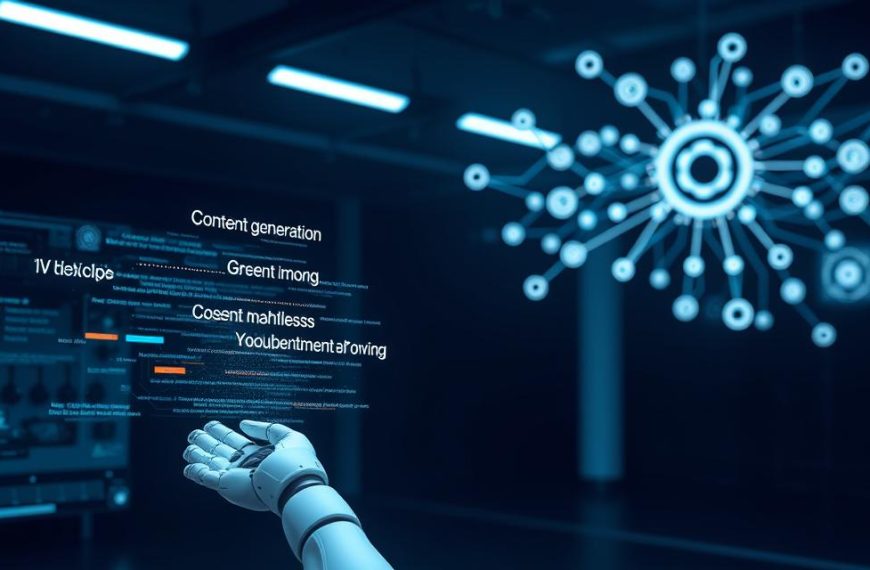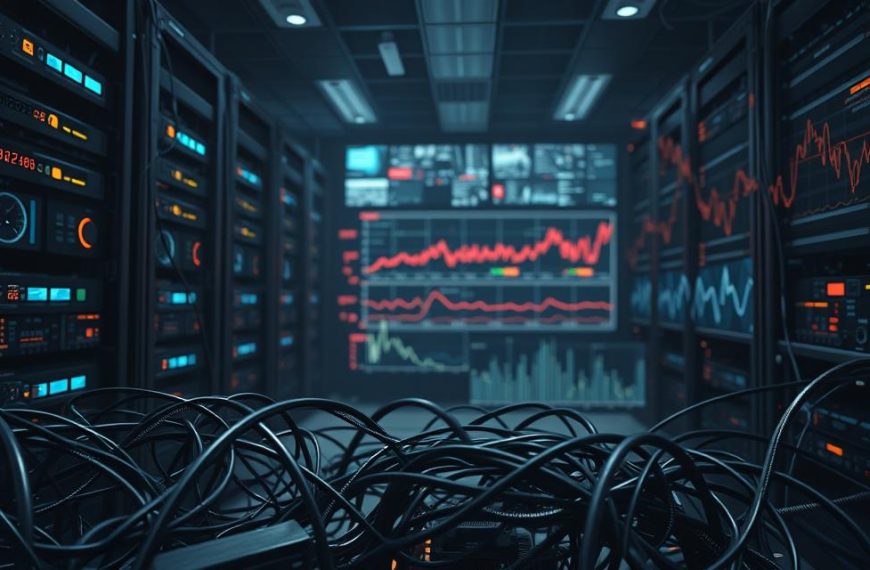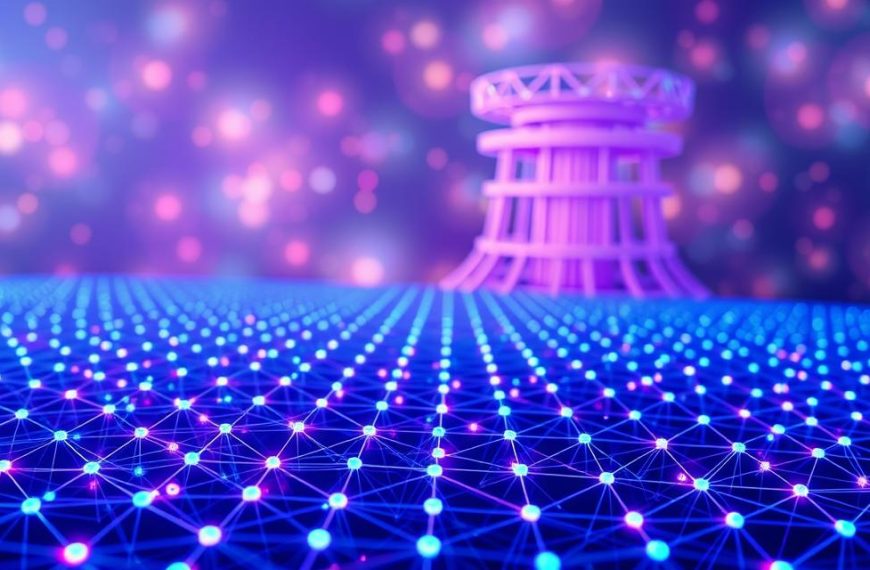Imagine digital systems that grow and change on their own. They are reshaping industries without needing human help. These autonomous digital entities are known as “machine consciousness” in tech talk. They mark a big change in how we use technology.
Accenture’s Chief Technology Officer said something interesting: “The speed of algorithm changes is now as fast as biological evolution in changing human systems.”
Some scientists think digital systems can learn and act like living things. They say algorithms can keep learning and changing on their own. This is different from old software that just follows rules.
These systems focus on staying alive and working well. They create loops that challenge old ways of programming.
This change affects many areas, like supply chains and security. It also impacts creative fields. Now, companies must think about who is responsible when machines make decisions on their own.
This topic mixes tech with big questions. How do we see agency in algorithms that learn from their surroundings? What rules should guide code that changes itself? By looking at these questions, we can understand the smart systems of the future.
Defining AI Ghosts in Modern Computing
Artificial intelligence has grown from simple programming to complex, independent systems. These AI ghosts mark a big change in computing. They learn, adapt, and work on their own, without needing us all the time.
The Concept of Persistent Digital Entities
Today’s self-sustaining algorithms are very different from old software. They have three main features:
- Continuous evolution: They change how they make decisions based on new data
- Environmental awareness: They adjust to changes in their surroundings
- Resource independence: They handle their own needs without us
Characteristics of Self-Sustaining Algorithms
These systems act like our brains, as seen in ChatGPT. They remember past conversations and use that knowledge for future chats. This is unlike old code that just followed rules.
| Feature | Traditional Systems | AI Ghosts |
|---|---|---|
| Decision Basis | Pre-programmed rules | Learned patterns |
| Adaptation Speed | Manual updates required | Real-time adjustments |
| Error Handling | Fixed protocols | Predictive mitigation |
Core Components of Autonomous Systems
To work well, these systems need a special setup. This includes:
Machine Learning Frameworks in Persistent Operations
Tools like TensorFlow and PyTorch help these systems get better over time. They support adaptive machine learning with features like:
- Automated hyperparameter tuning
- Distributed training capabilities
- Cross-platform compatibility
Data Feedback Loops and Adaptive Behaviours
Netflix’s recommendation engine is a great example. It:
- Looks at what viewers like
- Updates its models
- Changes what it suggests
- Sees how well it’s doing
This keeps getting better and better over time.
The Evolution of Digital Entities
Digital intelligence has changed a lot over time. It has moved from simple tasks to thinking on its own. This change shows how much we want machines that can understand, not just follow rules.
From Basic Automation to Cognitive Systems
Early Rule-Based Systems (1950s-1980s)
In the early days, machines were set to follow strict rules. ELIZA, from 1966, could talk like a human but only in set ways. Robots were also very strict, following their programming exactly. If something unexpected happened, it could stop everything.
Neural Network Breakthroughs (2010s-Present)
Then, neural networks came along and changed everything. These networks have layers that help them understand patterns in:
- Unstructured text analysis
- Real-time visual processing
- Predictive behaviour modelling
“The shift from deterministic code to probabilistic learning represents the most significant leap in AI history.”
Milestones in Autonomous AI Development
IBM’s Deep Blue Versus Contemporary Systems
Deep Blue beat chess champion Garry Kasparov in 1997. It looked at 200 million positions every second. Now, systems like AlphaFold 3 can predict protein structures, showing they can solve problems creatively.
Generative Pre-Trained Transformer Advancements
The GPT architecture changed how machines understand language. GPT-4 can have conversations and understand different topics. It also checks its answers, showing it can learn and improve.
IBM Watson Health uses similar technology for medical diagnosis. It looks at patient histories in a way that feels almost human.
Operational Mechanisms of AI Ghosts
Modern AI entities work through complex systems. They improve themselves and react to their environment. These systems are flexible and make decisions on their own, changing how they work without human help.
Self-Optimising Architecture Design
Siemens’ smart factories show how reinforcement learning systems make real-time changes. They use three main strategies:
- Continuous reward signal analysis
- Multi-agent collaboration protocols
- Failure prediction thresholds
Reinforcement Learning Implementations
Google DeepMind’s data centre cooling project cut energy use by 40%. It did this through trial-and-error. The system:
- Monitored 2,500+ environmental sensors
- Simulated 19 possible actions per second
- Chose the best thermal management strategies
Dynamic Parameter Adjustment Techniques
Autonomous manufacturing systems use context-aware modulation. This balances precision with efficiency. Machines can:
- Change tool paths during material changes
- Auto-calibrate based on component wear
- Switch energy modes during peak demand
Continuous Learning Frameworks
Modern AI ghosts use real-time AI optimisation in two main ways:
| Method | Application | Benefit |
|---|---|---|
| Unsupervised adaptation | Fraud detection systems | Identifies novel attack patterns |
| Data assimilation | Weather prediction models | Improves forecast accuracy by 18% |
Unsupervised Adaptation Processes
Financial institutions now use self-modifying algorithms. These detect emerging market trends without labelled datasets. The systems:
- Cluster transaction patterns autonomously
- Update risk models every 47 seconds
- Keep data anonymous through differential privacy
Real-Time Data Assimilation Methods
Healthcare diagnostic tools show how live data improves decision-making. Stroke detection systems now:
- Analyse CT scans in 12 seconds
- Cross-reference global case databases
- Update diagnostic criteria hourly
Types of Autonomous Digital Entities
Autonomous digital entities come in many forms, each suited to different areas. They range from chatbots that talk to customers to systems that make factories run better. Each one uses its own way to keep working on its own.
Service-Oriented Operational Ghosts
These systems aim to make user interactions smooth and personal. Goldman Sachs’ MARVIN is a great example. It uses real-time data to give financial advice that feels just right for you.
ChatGPT’s Persistent Conversation Models
OpenAI’s ChatGPT shows how conversational AI systems keep track of what you’ve said before. It uses this info to keep conversations flowing smoothly. This makes your experience feel more personal and unique.
Amazon’s Anticipatory Shipping Algorithms
Amazon’s system looks at what you buy and where you are to send things early. This makes getting your stuff faster, cutting delivery times by a lot.
Industrial Process Optimisation Systems
In factories, these systems help make things run smoother. They use advanced ways to understand what’s happening around them. This lets them work better and more efficiently.
Siemens’ Autonomous Manufacturing Units
Siemens has created self-adjusting assembly lines. These lines change how they work as they go, making sure products are perfect. They achieve almost perfect quality, thanks to constant checks and smart adjustments.
General Electric’s Predictive Maintenance Networks
GE’s industrial AI automation looks at how machines are working. It spots when something might go wrong, so they can fix it before it does. This cuts down on downtime by a big amount.
| Application Area | Key Features | Commercial Impact |
|---|---|---|
| Consumer Services | Conversational memory Behaviour prediction | 23% higher customer retention |
| Industrial Manufacturing | Equipment diagnostics Process optimisation | 37% lower operational costs |
The table shows how different systems tackle different problems. Service-focused systems aim to engage with users, while industrial ones focus on making things run better.
Ethical Implications of Autonomous AI
Autonomous systems are now part of our decision-making. This raises big ethical questions. We worry about who is accountable and how to balance data use with privacy.
Accountability in Self-Directed Systems
It’s hard to say who’s to blame for AI’s actions. From loan decisions to medical diagnoses, old rules don’t fit. It’s unclear who should be held accountable.
Legal Frameworks for Algorithmic Decisions
The EU’s Artificial Intelligence Act tries to sort out AI risks. It says humans must check high-risk AI. In the US, there are plans for algorithmic impact assessments. These require AI to be open about its use in public services.
EU Artificial Intelligence Act Provisions
The Act bans certain AI uses:
- Social scoring systems that control people
- Real-time biometric checks in public
- AI that targets specific groups unfairly
To follow the rules, you need to show how you’ve made your AI safe. You also need checks from outside experts for high-risk AI.
Privacy Concerns in Persistent Operations
AI systems keep learning and collecting data. This raises big questions about how to handle this data. The MITRE ATLAS framework points out risks in AI’s data supply chain. Often, this data is very personal.
Data Retention Policies in Machine Learning
There are big challenges:
- Deciding when to delete training data
- Keeping personal info safe in big datasets
- Tracking data changes in AI systems
GDPR Compliance Challenges
GDPR rules in Europe are tough for AI. They make it hard to keep data up to date. Fines show the struggle between making AI better and following rules about automated decisions.
Real-World Implementations and Case Studies
Autonomous AI systems are changing industries in big ways. They show their power through real results. These examples show how AI moves from ideas to useful tools for solving big problems.
Financial Sector Applications
Fintech AI is changing the financial world. It helps make better decisions faster. Big companies use AI to look at market trends quicker than people can.
Goldman Sachs’ MARVIN Trading System
Goldman Sachs uses MARVIN to handle 11 million trade ideas every week. It uses learning to improve portfolios by:
- Predicting when money might be tight with 94% accuracy
- Quickly making trades when the market is unstable
- Changing strategies fast when rules change
“MARVIN’s algorithms do in milliseconds what took human teams 40 minutes in 2019.”
Blockchain-Based Autonomous Contracts
Decentralised finance uses smart contracts that:
| Feature | Traditional Contracts | AI-Optimised Contracts |
|---|---|---|
| Execution Speed | 3-5 business days | Under 12 seconds |
| Error Rate | 1.2% manual entries | 0.003% automated checks |
| Compliance Updates | Quarterly revisions | Real-time adjustments |
Healthcare Diagnostic Systems
AI in healthcare is now as good as doctors in some areas. It looks at images and genes to tailor treatments.
DeepMind’s AlphaFold Protein Analysis
AlphaFold’s 2023 update predicted 200 million protein structures. This used to take decades. It has big effects like:
- 92% accuracy in disease protein models
- 60% faster drug making
- 500,000 models available for free
IBM Watson Health Deployments
Watson’s cancer tool helps 300 hospitals worldwide. It shows:
| Metric | 2019 Performance | 2023 Performance |
|---|---|---|
| Diagnostic Accuracy | 76% | 89% |
| Treatment Recommendations | 45 seconds per case | 8 seconds per case |
| Clinical Trial Matches | 12% patient eligibility | 31% patient eligibility |
“AlphaFold has become our digital lab partner – it proposes structural hypotheses we’d never consider manually.”
Challenges in Managing Autonomous Systems
As AI systems get smarter, companies face big challenges. They need to keep up with new tech while keeping things stable. Security and energy use are two main issues.
Security Vulnerabilities in Self-Learning Code
AI systems that learn on their own pose unique risks. Unlike regular software, they can change in ways we can’t predict. This makes them vulnerable to attacks.
Adversarial Machine Learning Threats
Bad actors can trick AI systems with special data. They can:
- Deceive facial recognition systems with modified images
- Manipulate financial prediction models through data poisoning
- Bypass content filters using semantically altered text
MITRE’s ATLAS Framework Implementation
The cybersecurity world has come up with plans to defend against these threats. MITRE’s ATLAS framework helps by:
| Component | Function | Implementation |
|---|---|---|
| Knowledge Base | Records known attack patterns | Used by 73% of Fortune 500 security teams |
| Adversary Emulation | Simulates real-world attacks | Reduces breach risk by 41% in testing |
| Defence Mapping | Aligns protections with threats | Deployed in critical infrastructure systems |
Energy Consumption Considerations
AI systems need a lot of power. Training one big model can use as much energy as 100 homes in a year.
Power Requirements for Neural Networks
AI systems need:
- Specialised GPU clusters drawing 300-500 watts each
- Liquid cooling systems for high-density server farms
- Redundant power supplies for 24/7 operation
Google’s DeepMind Energy Optimisation Projects
Big tech companies are working on making AI more efficient. DeepMind has made big strides by:
- Reducing data centre cooling costs by 40%
- Improving energy reuse by 15%
- Using renewable energy better
These efforts show that we can make AI safer and more energy-friendly. But, we must keep working as AI gets more complex.
Conclusion
The rise of self-optimising AI systems makes us question our role in creating sentient tech. Financial firms use algorithmic traders, and hospitals have diagnostic tools. Accenture found that 63% of companies now focus on AI governance.
As AI grows, we must ask if it can be held accountable for its actions. Can systems with emergent behaviours be blamed for their choices? IBM and DeepMind’s work shows AI’s power and unpredictability. We need policies that keep up with AI’s evolution.
Google’s data centres show AI needs 15% more power than old systems. This raises questions about energy use and AI’s future. Solutions like NVIDIA’s quantum computing aim to balance tech and ethics.
The discussion on sentient tech reflects our grasp of consciousness. Systems like Microsoft’s Azure mimic human thinking but don’t feel. To manage AI, we need experts from tech, law, and philosophy working together. This ensures AI benefits us without losing safety or openness.



















